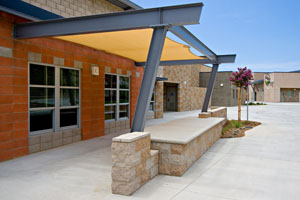Masonry Facts

Fact #101
Many of the world's significant architectural achievements were built with masonry.
Fact #102
Masonry is resistant to fire, earthquakes, and sound.
Fact #103
The skill and precision of the mason can never be replaced by machines.
Fact #104
Architects and builders choose masonry for its beauty, versatility, and durability.
Fact #105
Brick is man's oldest manufactured product.
Fact #106
Sun-baked clay bricks were used in buildings over 6,000 years ago.
Fact #107
Brick is composed of shale and clay.
Fact #108
Brick is fired in kilns of approximately 2,000° F.
Fact #109
Cavity walls were developed to reduce water penetration problems.
Fact #110
Concrete blocks are composed of cement, sand, and lightweight aggregate.
Fact #111
When exposed to fire, masonry does not burn, melt, twist or warp.
Fact #112
Masonry is the most environmentally-friendly building system available.
Fact #113
Masonry construction requires less insulation than other building systems.
Fact #114
Masonry is slow to absorb or lose heat.
Fact #115
Masonry can be easily recycled.
Fact #116
Masonry does not emit toxins during a fire.
Fact #117
Masonry materials do not emit volatile gases.
Fact #118
Masonry buildings have been known to last for hundreds - even thousands - of years.
Fact #119
Masonry materials come in hundreds of colors and decorative finishes.
Fact #120
Masonry offers great design versatility.
Fact #121
Over 70% of the buildings in the world are built of masonry.
Fact #122
Masonry structures have lower insurance costs than non-masonry structures.
Fact #123
Masonry materials are made entirely or primarily of natural ingredients.
Fact #124
Masonry materials include clay brick, concrete masonry units and stone.
Fact #125
Brick homes command an average 6% higher resale price than non-brick homes.
Fact #126
Masonry guidelines ensure that structures are built to resist fire, hail and wind.
Fact #127
Masonry ordinances are growing in popularity in every part of the country.
Fact #128
Masonry buildings show little distress from impact of flying debris during tornados.
Fact #129
Masonry's life cycle is unsurpassed by any other building material.
Fact #130
Masonry enhances the occupants' comfort and health.
Fact #131
Masonry is fireproof, and water and insect resistant.
Fact #132
Masonry is virtually impervious to the ravages of time and weather.
Fact #133
Masonry is a natural insulator.
Fact #134
Masonry is anything constructed of the materials such as stone, brick or block.
Fact #135
Masonry is resistant to mold.
Fact #136
Masonry is one hundred percent durable.
Fact #137
Masonry does not support mold growth.
Fact #138
Masonry does not provide a food source for mold spores.
Fact #139
Masonry limits moisture penetration.
Fact #140
Masonry is a skilled trade that takes much time, effort and talent to learn.
Fact #141
Masonry allows for more creativity and flexibility in designing projects.
Fact #142
A mason knows different patterns, textures and colors to create a beautiful product.
Fact #143
Every brick and block must be laid by hand, and requires the skill of a craftsman.
Fact #144
Protective sheet enclosed work areas allow masons to work throughout the year.
Fact #145
Masons must be able to read blueprints and understand building codes.
Fact #146
Masonry has been used for more than 6000 years.
Fact #147
The United States standard brick size is 2 1/2 x 3 3/4 x 8 inches.
Fact #148
Masonry will not decay or rot if exposed to mold.
Fact #149
Masonry structures provide durable fire resistance.
Fact #150
A mason is a craftsman who works with stone or brick.
Fact #151
One 8 in. CMU can handle 205 sumo wrestlers weighing 500 pounds each.
Fact #152
Ancient Egyptian mortars were made from burned gypsum and sand.
Fact #153
Ancient Egyptians used horses and carriages to carry supplies up scaffolding.
Fact #154
The Great Pyramid of Giza is over 5,000 years old and uses 2,300,000 blocks of stone.











